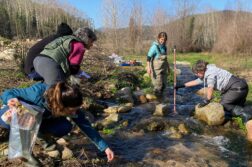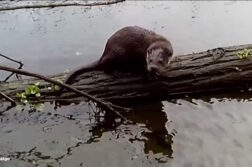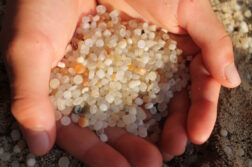Humanity is currently facing the challenge of plastic pollution in the environment which is rising up as a chronic contamination problem worldwide. Much is known about the occurrence in the environment and toxicity of plastic, especially microplastics (MicP). However, our understanding about the processes that explain the dynamics of plastic in the environment, which is nowadays the dominant type of Anthropogenic Particulate Organic Matter (APOM), is still scarce. Plastic pollution is one of the effects of global change that co-occurs in fluvial ecosystems with many other environmental challenges such as river morphology alteration, water scarcity, increase of extreme weather events and eutrophication, among others.
This situation is of special concern in Mediterranean rivers that suffer high environmental pressures derived from human activity and climate change. The APOM-cycling project is willing to answer a very specific and relevant research question: understanding transport and retention of APOM in Mediterranean streams under global change.
The methodology applied will combine empirical in situ research that will be done in La Tordera River, and experimental work that will be carried out in two experimental facilities: indoor and outdoor experimental channels. La Tordera River has an heterogeneous mosaic of land uses and human activities that translates into a large variability in the amount and apportionment of pollution sources across the catchment as well as in the alteration of the channel morphology. Due to the climate of the region, stream hydrology is characterized by floods and droughts and the presence of streams with either permanent or intermittent hydrological regimes within the catchment.
APOM-cycling will investigate the influence of different land-uses on MicP and macroplastics (MacP) occurrence; and the contribution of channel morphology, trophic status (nutrients), and extreme weather events (floods and droughts) to transport and retention of APOM in La Tordera River. Two experiments will be performed to address the biofilm- mediated transient storage of MicP; and to assess the specific contribution of nutrients and grazers (indoor channels), and the influence of water intermittence (outdoor channels) on MicP retention and trophic transfer. The data obtained will be used for the development of a parametrized model on the spatial and temporal dynamics of APOM in Mediterranean rivers under the influence of global change.
A relevant contribution of the project will be that resulting from the in-situ activities, including citizen science, providing education and awareness to the population, and linking the activities to one specific geographical area with its real and actual environmental issues. Also, the research is an excellent opportunity to promote the training and formation of young students/researchers into innovative and relevant research.
PRINCIPAL RESEARCHERS: Eugènia Martí i Helena Guasch
Other researchers and CEAB’s personal working in this project: Berta Bonet, Miquel Ribot, Sara Castelar, Stephanie Merbt and David Pineda.




